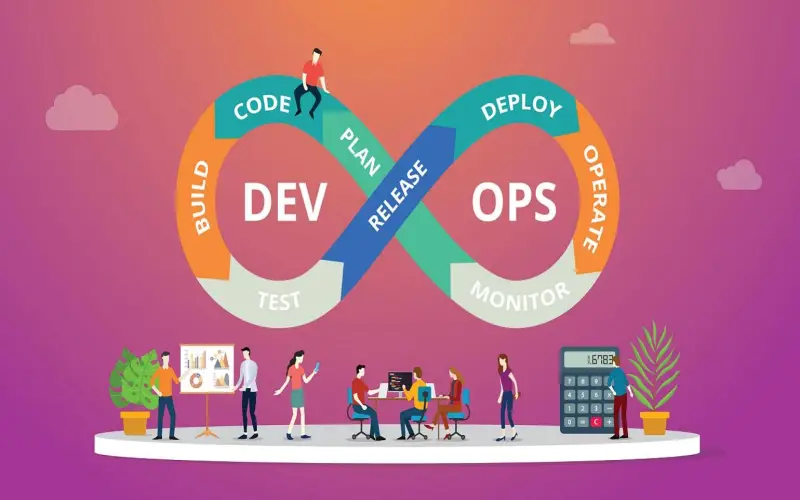DevOps is a group of people who work together to make software and products quickly and safely. It helps the devs (people who create the software) and ops (those people who deploy software) to work better together. They do this by using tools, talking to each other, and making the software in parts with constant improvement in features and security. DevOps is all about ensuring the developers who create the software and the operators who deploy it all work together. This way, they can fix problems and develop things faster and more effectively. DevOps is all about teamwork and making software better step by step. Let us explore DevOps by looking at the Top 10 Benefits of adopting DevOps in the organization.
1. Better Team Collaboration
One of the most important aspects of DevOps is better team collaboration. It allows teams like development and operations to collaborate and communicate faster than before. It increases communication and trust between individual team members by sharing knowledge, inputs, codes, perspectives, and specific understanding and working of tools among themselves. DevOps uses agile methodology as these are ideal for converting complex tasks into simple and manageable systems. This results in better planning and project management processes across the board.

2. Greater Security
A broader view of DevOps is DevSecOps, which merges teams like development and operation with the security team. In this aspect, the developer focuses on security checks, cloud monitoring, regular examinations, and code reviews to prevent security breaches and vulnerabilities that could happen after the development process. After the software development process is completed, bugs and problems are more complex to fix as it requires finding the reason and code leading to issues. DevSecOps helps find and fix security issues early and faster, ensuring better security in your products and software.

3. Improved Efficiency
DevOps is beneficial for any organization as it can improve work efficiency in several ways. DevOps methods require using a few automated tools such as Docker, Git, AWS, Kubernetes, and more. With the help of these automated tools, the development and operations teams can quickly find and take action on potential issues with software without wasting any time. It allows the units to iterate and innovate continuously more rapidly than your competitor companies and organizations.

4. Continuous Software Delivery
Continuous software delivery is a technique related to software development in which code changes are automatically generated, prepared for release into the production environment, and tested. It is a feature of DevOps that has evolved from continuous integration (CI) where all code changes are deployed to the testing or production environment for the build stage. The use of microservices architecture makes this even better and more reliable as developers can share the responsibility of creating software by breaking it into microservices, leading to a safer and easy-to-track environment.

5. High-Quality Products
High-quality products are made possible by reducing bugs and providing constant software patches. Continuous integration and automated testing of software are capabilities of team-level organizations whereas organization-level capabilities include setting architectures or changing approval policies that spread across departments and teams. These capabilities and efforts lead to the release of higher quality software products into the market.

6. Faster Updates
DevOps is also very advantageous at giving faster updates as developers and operation teams are constantly looking for security issues and vulnerabilities in software or products. The use of CI (continuous integration) is a core element in any DevOps team. By using this, teams are more likely to find bugs or issues within the software (product) before the launch in the market. It also includes features like early software launches and fixing bugs before they become hard to track and improve by deploying patches through the cloud.

7. Quick Recovery
The fundamental concept of DevOps such as CI (Continuous integration) and CD (Continuous Delivery) focuses on integrating all code changes into the main branch, then testing them, and automatically building the final package. Continuous delivery works with continuous integration and helps automate the software release processes. As the team has adopted DevOps, the collaboration is fast they share software responsibilities and communicate to combine workflows throughout departments leading to the recovery of systems and servers faster and efficiently.

8. Employee Engagement
DevOps adopted the DIY (Do it yourself) methodology on top of and between their tools. It makes developers and operators focus on issues and the development process, which provides excellent employee engagement. DevOps believes in the removal of institutional strict rules that lead to barriers and constraints for employees, instead focusing on a friendly and healthy work environment for continuous growth.

9. Reduced Time On Unplanned Work
From features like automating continuous repetitive tasks to monitoring performance metrics, this leads to reduced release times or mean-time-to-recovery. High-performing DevOps teams regularly look for areas that could be improved in terms of performance, security, and reliability. Through automation, improved communication in the organization, and faster collaborations the DevOps team focus on what real users want from the organization and think about bringing the features required by the customer to the software. Developers and system administrators use automated tools to configure operating systems, host machines, and much more. Using this automation code leads to no extended use of manually configuring the operating system. It makes the system operate faster and reduces the waste of time on unplanned work and issues.

10. Competitive Advantage
At last, we have the most critical competitive advantage, as other organizations also could be working on similar domains. It requires the upper hand in the market, as there is constant completion involved. DevOps helps organizations create and build more significant and more consistent products and software, leading to improved customer satisfaction and software update delivery. After all, the primary goal of any organization is to solve some real-world problem, by providing customers with what they need.



















